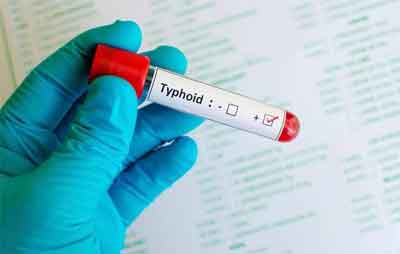- Home
- Editorial
- News
- Practice Guidelines
- Anesthesiology Guidelines
- Cancer Guidelines
- Cardiac Sciences Guidelines
- Critical Care Guidelines
- Dentistry Guidelines
- Dermatology Guidelines
- Diabetes and Endo Guidelines
- Diagnostics Guidelines
- ENT Guidelines
- Featured Practice Guidelines
- Gastroenterology Guidelines
- Geriatrics Guidelines
- Medicine Guidelines
- Nephrology Guidelines
- Neurosciences Guidelines
- Obs and Gynae Guidelines
- Ophthalmology Guidelines
- Orthopaedics Guidelines
- Paediatrics Guidelines
- Psychiatry Guidelines
- Pulmonology Guidelines
- Radiology Guidelines
- Surgery Guidelines
- Urology Guidelines
Metabolic markers accurately diagnose typhoid fever

Researchers have identified a metabolite 'signature' that can accurately distinguish typhoid from other fever-inducing tropical diseases using patient blood samples.
The research, published in the journal eLife, builds on previous results from 2014 showing that metabolite markers can distinguish between typhoid infection caused by different organisms.
Many tropical diseases, such as typhoid and malaria, present with similar symptoms, making accurate diagnosis challenging and delaying effective treatment. A further problem with diagnosing typhoid is that currently available tests are not sensitive enough, and some patients are later found to have the disease, even though an organism cannot be cultured from their blood.
The researchers used an approach called 'metabolomics', which involves measuring many small metabolites in a biological sample, to try and identify patterns that are unique to different diseases. In a previous study, they used this method to identify metabolic 'signatures' that could successfully differentiate between typhoid caused by two closely related organisms -- Salmonella Typhi and Salmonella Paratyphi A.
"We wanted to assess if metabolomics could accurately diagnose typhoid in patients from different regions with a wider range of tropical diseases," says senior author Professor Stephen Baker, molecular microbiologist at Oxford University Clinical Research Unit, Vietnam. "We thought that this approach would more closely reflect the real situation where patients with fever-inducing diseases present with non-specific symptoms."
Baker and his research collaborators collected blood samples from multiple patients from Bangladesh, who fell into three groups: patients who had Salmonella Typhi in their blood, those who were suspected of having typhoid from their symptoms, and a third group who were suspected of having a different tropical disease characterised by fever (a 'fever-control' group).
Using mass spectrometry, the team analysed the metabolites in each patient blood sample to generate a metabolic 'signature' for two patient groups: those whose blood tested positive for typhoid, and fever controls. They then used this as a model to predict the identity of individual samples in a third group: patients suspected of having typhoid from their symptoms. They found that the model had excellent predictive power for distinguishing between culture-positive typhoid patients and patients with other types of tropical disease.
"A major challenge in typhoid diagnosis is diagnosing true typhoid patients who have a negative blood culture result," explains first author Elin Näsström, a graduate student at Umeå University, Sweden. "We wanted to see if the detected metabolomics could help further distinguish these groups."
As hoped, their predictive model pinpointed five out of nine blood-test-negative samples that were actually typhoid positive. And three out of five patients who were suspected of typhoid from their symptoms were also indicated to be typhoid-positive by their metabolite signature.
To validate the signature further, the team studied an additional collection of blood samples from patients in Bangladesh and Senegal. They then compared these profiles against the original data from Nepal patients, published in the 2014 study by Näsström et al. From these combined analyses, they identified 24 metabolites that were consistently different between patients who had typhoid, and those who had other diseases including malaria.
"Our results demonstrated a metabolite panel that can distinguish typhoid from other fever-inducing diseases, providing a new approach for typhoid diagnostics," Baker concludes.
"The next challenges are to corroborate these metabolites in larger patient numbers and try and incorporate them into simple diagnostic test formats. This approach could be potentially expanded into other tropical diseases, eventually allowing for more accurate diagnosis and more effective treatment, and hopefully reducing the use of unnecessary antimicrobials."
Full Article by : Elin Näsström, Christopher M Parry, Nga Tran Vu Thieu, Rapeephan R Maude, Hanna K de Jong, Masako Fukushima, Olena Rzhepishevska, Florian Marks, Ursula Panzner, Justin Im, Hyonjin Jeon, Seeun Park, Zabeen Chaudhury, Aniruddha Ghose, Rasheda Samad, Tan Trinh Van, Anders Johansson, Arjen M Dondorp, Guy E Thwaites, Abul Faiz, Henrik Antti, Stephen Baker. Reproducible diagnostic metabolites in plasma from typhoid fever patients in Asia and Africa. eLife, 2017; 6 DOI: 10.7554/eLife.15651

Disclaimer: This site is primarily intended for healthcare professionals. Any content/information on this website does not replace the advice of medical and/or health professionals and should not be construed as medical/diagnostic advice/endorsement or prescription. Use of this site is subject to our terms of use, privacy policy, advertisement policy. © 2020 Minerva Medical Treatment Pvt Ltd